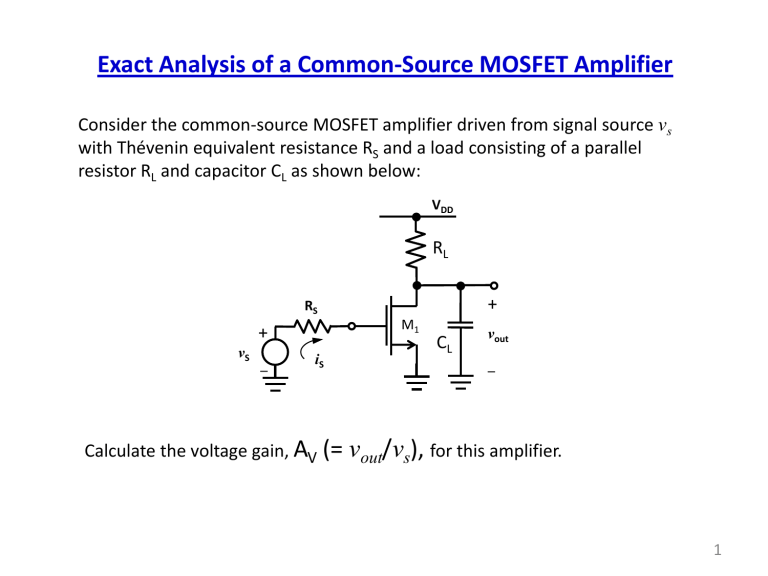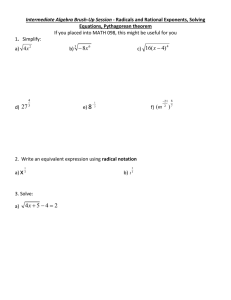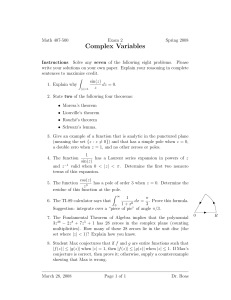Exact Analysis of a Common-Source MOSFET Amplifier (= v /v

Exact Analysis of a Common-Source MOSFET Amplifier
Consider the common-source MOSFET amplifier driven from signal source v s with Thévenin equivalent resistance R
S
and a load consisting of a parallel resistor R
L
and capacitor C
L
as shown below:
V
DD
R
L
+ v
S
_
R
S i
S
M
1
+
C
L v out
_
Calculate the voltage gain,
A
V
(= v out
/ v s
), for this amplifier.
1
We start with the small-signal equivalent circuit: v
S
+
_
R
S i
S
C gs
C gd
+
_ v gs g m v gs r
O
R
L
+
C
L _ v out
R
L,eq
= r
O
|| R
L
We can combine the parallel combination of R
L
and r o
as indicated.
The branch currents are indicated in the figure on the next slide.
2
v
S
+
_
R
S i
S i
S sC gd
(v gs
– v out
)
C gd
C gs
+ sC gs v gs
_ v gs v out r
O
|| R
L g m v gs sC
L v out r
O
|| R
L
+
C
L _ v out
Equating the current through C gd to the three shunt currents at the output: sC gd
v gs
v out
v out
L
Now solving for v g s
: v gs
v out m
(
O L
)
1 (
L
C gd
) ( r R
L
1
C gd g m
)
At the input loop: v
S
i R
S
v gs
3
v
S
+
_
R
S i
S i
S sC gd
(v gs
– v out
)
C gd
C gs
+ sC gs v gs
_ v gs v out r
O
|| R
L g m v gs sC
L v out r
O
|| R
L
+
C
L _ v out
Using KCL at the gate node: i
S
sC v gd
( gs
v out
) and then we can write v
S
v gs
1 ( gs
gd
)
S
sC R v
After a lot of algebra we can write the final expression (on next page).
4
v out v
S
1
m
(
O L
) 1 s
C gd g m
gd
(1 m
(
O L
)) R
S
( C gd
C
L
) ( r R
L
)
s 2
( C gd
L
) gs
C C gd S
(
O L
)
Now look at the denominator D(s) – We can write in the form,
s
1 p 1
1 p 2
s 2
1
p 2
1 s
p 1
1 s
p 2
So we have two poles which are written on the next page:
p1 and
p2
.
5
p 1
1
C gs
C gd
(1 m
(
O L
)) R
S
( C gd
L
)(
O
Miller capacitance term
p 2
C gs
C gd
(1 m
(
O L
)) R
S
( C gd
L
)(
O
( C gd
L
) gs
S
(
O L
)
L
)
L
)
Often we have a “dominant pole” – meaning the other pole is 4 times greater in magnitude than the dominant pole
p1
. Returning to the definition of D(s):
s
1 p 1
1 p 2
s 2
1
p 2
1 s
p 1
1 s
p 2
s
1 p 1
s 2
1
p 2
where p 1 is the dominant pole.
6
s p 1
s 2
p 2
, where p 1 is the dominant pole.
j
p2
Because
1 p 1
1 p 2
p1
7
DIGRESSION:
If you have a quadratic polynomial of the form: as 2 + bs + c = 0
Then the solution can be found from s
1,2
b 2 2 ac
2 a
You may have two real roots, or you may have a complex conjugate pair of roots of the form s
1,2
=
j
j
|H|
f
Inductance involved
8
Miller’s Theorem (from Razavi)
• If A v is the voltage gain from node 1 to 2, then a floating impedance Z
F can be converted to two grounded impedances Z
1 and Z
2
:
V
1
V
2
Z
F
V
Z
1
1
Z
1
Z
F
V
1
V
1
V
2
Z
F
1
1
A v
Z
F
2
V
2
Z
2
Z
2
Z
F
V
2
2
Z
F
1
1
1
A v
9
Miller’s Theorem (continued)
• Applying Miller’s theorem, we can convert a floating capacitance between the input and output nodes of an amplifier into two grounded capacitances.
• The capacitance at the input node is larger than the original floating capacitance.
Z
2
1
Z
F
1
A v
1
1
1
F
A v
j
1
1
1
A v
C
F
Z
1
1
Z
F
A v
1
1
F
A v j 1
1
F
10
C gs
0
0
C gd
0
Application of Miller’s Theorem - I
Miller’s Theorem
A
V
g R
D
Capacitor C in is given by
C in
C
F g R
D
)) C
F
(1 g R
D
)
Capacitor C out is given by
C out
C
F
1
1
g R
D
C
F
1
1 g R
D
11
C gs
0
0
C gd
0
Application of Miller’s Theorem - II
Miller’s Theorem
Pole at Input:
in
R
G
1
1 g m
R
D
A
V
g R
D
C
F
Pole at Output:
out
R
D
1
1
1 g m
R
D
C
F
12
Back to our common-source MOSFET amplifier v
S
+
_
R
S i
S
C gs
C gd
+
_ v gs g m v gs r
O
R
L
+
C
L _ v out
R
L,eq
= r
O
|| R
L
What is the midband voltage gain A
V
?
Set all capacitors to open circuits for midband voltage gain calculation.
R
S v
S
+
_
+
_ v gs g m v gs r
O
R
L
+
_ v out
R
L,eq
= r
O
|| R
L
A
V
m
(
O L
)
13
Applying Miller’s Theorem to CS MOSFET Amplifier
R
S v
S
+
_ i
S
C in
+
_ v gs g m v gs r
O
|| R
L
+ v out
C out
_
C in
C gs
C gd
1 g r R
L
C out
C
L
C gd
1
1 m
(
O L
Now we have only an input loop and an output loop to deal with.
This means we will have an input pole and an output pole to contend with.
14
Applying Miller’s Theorem to CS MOSFET Amplifier
If the voltage gain is large, the input pole frequency will be lower than the output pole frequency. The input pole is then the dominant pole in this amplifier. v out v
S v out v
S
1
g m sR C in
1 (
O
(1
sR C in m
(
O L
)(1 (
O
)
L
L
) out
L
) out
)
Input pole Output pole
The input pole is given by s in
C gs
C gd
1
1 m
(
O L
R
S
15
Comparing dominant pole terms
from “exact analysis” to that from Miller’s Theorem
From our “exact analysis”:
p 1
1
C gs
C gd
(1 m
(
O L
)) R
S
( C gd
L
)(
O
From our analysis using Miller’s theorem:
L
) s in
p 1
C gs
C gd
1
1 m
(
O L
R
S
16
Putting some numbers to our CS MOSFET Amplifier
C gs
= 25 fF; C gd
= 5 fF; C
L
= 12 fF r g m
= 2 mA/V ( mmho )
R
S
= 5,000
; r
O
= 20,000
; R
L
= 5,000
O
||R
L
= 4,000
and A
V
= - g m
(r
O
||R
L
) = - 8
[1 + g m
(r
O
||R
L
) ] = 9
in f in
C gs
C gd
1
1 m
(
O L
R
S
25 fF
2 in
454 MHz
1
17
Putting some numbers to our CS MOSFET Amplifier
For the output pole we have f out
2
C
L
C gd
1
1
1 m
(
O L
( r R
L
)
2,266 MHz
Clearly the input pole is dominant at 454 MHz.
18
Dominant pole from “exact analysis” f p 1
2
1
C gs
C gd
(1 m
(
O L
)) R
S
( C gd
L
)(
O L
)
Additional term
Compared to the Miller capacitance. f p 1
2 C gs
C gd
1
1 m
(
O L
R
S
The added term lowers the break frequency from 454 MHz down to 381 MHz.
19
NEXT: Open-Circuit Time Constant Analysis
( ) K
1 a s a s 2
1 b s b s 2 m n
When the poles and zeros are easily found, then it is relatively easy to determine the dominant pole. But often it is not easy to determine the dominant pole.
The coefficient b
1
is especially important because b
1
1 p 1
1 p 2
1 p 3
1
pn
How do we determine the
pi values? We will consider all capacitors in the overall circuit one at a time.
20
Open-Circuit Time Constant Analysis
We consider each capacitor in the overall circuit one at a time by setting every other small capacitor to an open circuit and letting independent voltage sources be short circuits.
The value of b
1
is computed by summing the individual time constants, called “open-circuit time constants.” and
H b
1
1 b
1 i n
1
1
Time constant = RC i n
1
21
Open-Circuit Time Constant Rules
• For each “small” capacitor in the circuit:
– Open-circuit all other “small” capacitors
– Short circuit all “big” capacitors
– Turn off all independent sources
– Replace cap under question with current or voltage source
– Find equivalent input impedance seen by capacitor
– Form RC time constant
• This procedure is best illustrated with an example…
22



